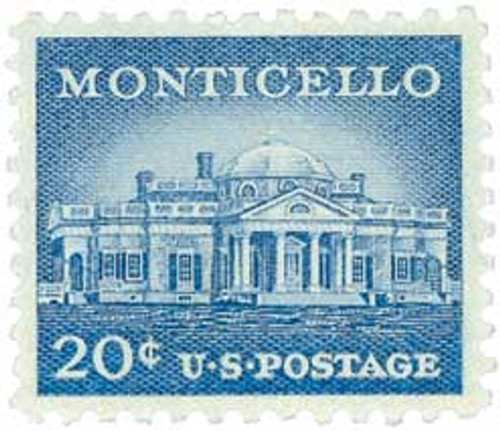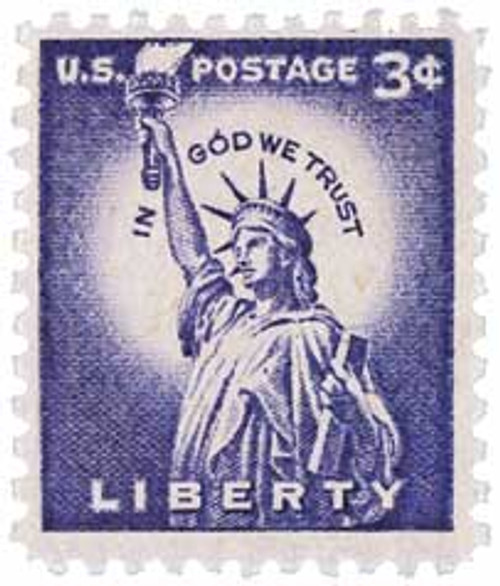
1956 Liberty Series,20¢ Monticello
# 1047 - 1956 Liberty Series - 20¢ Monticello
$0.35 - $115.00
U.S. #1047
20¢ Monticello
Liberty Series
20¢ Monticello
Liberty Series
Issue Date: August 26, 1956
City: Chicago, IL
Printing Method: Rotary press (wet and dry printings)
Perforations: 10.5 x 11
Color: Ultramarine
City: Chicago, IL
Printing Method: Rotary press (wet and dry printings)
Perforations: 10.5 x 11
Color: Ultramarine
The Liberty Series
Issued to replace the 1938 Presidential series, this patriotic set of stamps honors guardians of freedom throughout U.S. history. Eighteenth Century America is represented by Revolutionary War heroes and statesmen such as Washington, Jefferson, Franklin, Hamilton, Henry, Jay, and Revere.
Leaders of the 19th century including Monroe, Lincoln, Lee, Harrison, and Susan B. Anthony make an appearance. The 20th century is represented by Teddy Roosevelt, Woodrow Wilson, and General Pershing.
The Liberty Series also features famous locations important to America’s democratic history, such as Bunker Hill, Independence Hall, and the Alamo.
“Wet” versus “Dry” Printing
The Bureau of Engraving and Printing began an experiment in 1954. In previous “wet” printings, the paper had a moisture content of 15 to 35 percent. In the experimental “dry” printings, the paper had a moisture content of 5 to 10 percent. This process required stiffer, thicker paper, special inks, and greater pressure to force the paper through the plates.
Stamps produced by dry printing can be distinguished by whiter paper and higher surface sheen. The stamps feel thicker and the designs are more pronounced than on wet printings. The experiment was a success, and all U.S. postage stamps have been printed by the dry method since the late 1950s.
Monticello and the Early Career of
Thomas Jefferson (1743-1826)
Thomas Jefferson (1743-1826)
Thomas Jefferson was born in Goochland (now Albemarle) County, Virginia. His father died when Thomas was 14, and as the oldest boy, Jefferson became head of the family. He inherited more than 2,500 acres of land, and between 20 and 30 slaves. He received a first-rate education at William and Mary College in Williamsburg, and then studied law with George Wythe, one of the greatest law teachers in America. Jefferson practiced law from 1767 until 1774, when the American Revolution closed the courts. From 1769 to 1775, he served in the House of Burgesses, where he showed his great talents as a committeeman and skillful draftsman.
In 1768, Jefferson began planning his now-legendary mansion home, Monticello, and construction began in 1770. In 1772, Jefferson married Martha Wayles Skelton (1748-1782), a wealthy widow. The couple moved into Monticello, which was not fully completed until 1809. The Jeffersons had five children. Only two survived into adulthood – Martha (1772-1836) and Mary (1778-1804). Mrs. Jefferson died in 1782, after 10 years of marriage. Jefferson raised his two daughters and never re-married.
From the very start of the struggle with Britain, Jefferson was an outspoken leader for the Colonial cause. Jefferson represented Albemarle County at the First Virginia Convention, which was held to elect Virginia delegates to the First Continental Congress. However, he became ill and was unable to attend, but sent a letter stating his beliefs. Jefferson held the view that settlers in America had used their “natural rights.” These settlers owed allegiance only to the king, with whom they chose to stay loyal, and not to the British Parliament. He compared the first English settlers to the Saxons, who had left the area of present-day Germany and settled England hundreds of years before. He claimed the British Parliament had no more right to govern America than German leaders had to govern England. Jefferson published his views in a pamphlet titled A Summary View of the Rights of British America in 1774.
U.S. #1047
20¢ Monticello
Liberty Series
20¢ Monticello
Liberty Series
Issue Date: August 26, 1956
City: Chicago, IL
Printing Method: Rotary press (wet and dry printings)
Perforations: 10.5 x 11
Color: Ultramarine
City: Chicago, IL
Printing Method: Rotary press (wet and dry printings)
Perforations: 10.5 x 11
Color: Ultramarine
The Liberty Series
Issued to replace the 1938 Presidential series, this patriotic set of stamps honors guardians of freedom throughout U.S. history. Eighteenth Century America is represented by Revolutionary War heroes and statesmen such as Washington, Jefferson, Franklin, Hamilton, Henry, Jay, and Revere.
Leaders of the 19th century including Monroe, Lincoln, Lee, Harrison, and Susan B. Anthony make an appearance. The 20th century is represented by Teddy Roosevelt, Woodrow Wilson, and General Pershing.
The Liberty Series also features famous locations important to America’s democratic history, such as Bunker Hill, Independence Hall, and the Alamo.
“Wet” versus “Dry” Printing
The Bureau of Engraving and Printing began an experiment in 1954. In previous “wet” printings, the paper had a moisture content of 15 to 35 percent. In the experimental “dry” printings, the paper had a moisture content of 5 to 10 percent. This process required stiffer, thicker paper, special inks, and greater pressure to force the paper through the plates.
Stamps produced by dry printing can be distinguished by whiter paper and higher surface sheen. The stamps feel thicker and the designs are more pronounced than on wet printings. The experiment was a success, and all U.S. postage stamps have been printed by the dry method since the late 1950s.
Monticello and the Early Career of
Thomas Jefferson (1743-1826)
Thomas Jefferson (1743-1826)
Thomas Jefferson was born in Goochland (now Albemarle) County, Virginia. His father died when Thomas was 14, and as the oldest boy, Jefferson became head of the family. He inherited more than 2,500 acres of land, and between 20 and 30 slaves. He received a first-rate education at William and Mary College in Williamsburg, and then studied law with George Wythe, one of the greatest law teachers in America. Jefferson practiced law from 1767 until 1774, when the American Revolution closed the courts. From 1769 to 1775, he served in the House of Burgesses, where he showed his great talents as a committeeman and skillful draftsman.
In 1768, Jefferson began planning his now-legendary mansion home, Monticello, and construction began in 1770. In 1772, Jefferson married Martha Wayles Skelton (1748-1782), a wealthy widow. The couple moved into Monticello, which was not fully completed until 1809. The Jeffersons had five children. Only two survived into adulthood – Martha (1772-1836) and Mary (1778-1804). Mrs. Jefferson died in 1782, after 10 years of marriage. Jefferson raised his two daughters and never re-married.
From the very start of the struggle with Britain, Jefferson was an outspoken leader for the Colonial cause. Jefferson represented Albemarle County at the First Virginia Convention, which was held to elect Virginia delegates to the First Continental Congress. However, he became ill and was unable to attend, but sent a letter stating his beliefs. Jefferson held the view that settlers in America had used their “natural rights.” These settlers owed allegiance only to the king, with whom they chose to stay loyal, and not to the British Parliament. He compared the first English settlers to the Saxons, who had left the area of present-day Germany and settled England hundreds of years before. He claimed the British Parliament had no more right to govern America than German leaders had to govern England. Jefferson published his views in a pamphlet titled A Summary View of the Rights of British America in 1774.




















